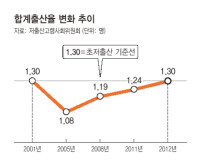hankyoreh
Links to other country sites 다른 나라 사이트 링크
Low South Korean birth rate shows signs of increasing

By Kim Yang-joong, medical correspondent
Last year, the total fertility rate (TFR) in South Korea is believed to have increased to 1.3, giving rise to hopes that the country will emerge from the ranks of countries with low birth rates for the first time in 11 years. The total fertility rate represents the number of children born during the period when a woman is capable of giving birth (15 to 49 years of age)
The prediction is based on data from a Jan. 25 meeting of the Presidential Committee on Low Birth Rate and an Aging Society. The data, which combined the number of babies born through November 2012 with the average of babies born in December over the past three years, indicates that the birth rate for 2012 was around 1.3 children. The number of babies born from January to November of 2012 was 450,600, which is 13,300 more than the 437,300 born during the same period of 2011. The precise TFR figures will be announced in August 2013.
The South Korean TFR, which stood at 1.3 in 2001, dropped to a low point of 1.08 in 2005 before bouncing back to 1.24 in 2011. If last year’s birth rate coincides with the predicted figures, it will mean that Korea has reached 1.3 babies, the cut-off line for an extremely low birth rate, only seven years after bottoming out. Compared with the length of time that an extremely low birth rate has persisted in other major countries, Korea has taken longer than Germany (4 years) but was faster than Greece (9 years) and Italy (11 years).
“Since the implementation of the basic laws concerning the low birthrate and aging society in 2005, we have devised plans on two occasions as part of our efforts to reduce the expenses incurred in marriage, childbirth, and childcare,” the committee said. “This result is the fruit of our efforts.”
However, the birthrate in South Korea remains low compared to fully developed countries. “Various European countries that experienced a low birth rate devised policies to overcome it, and as a result they are currently maintaining a level of 1.8 to 1.9 babies,” said a representative for the Ministry of Health and Welfare.
“Korea must also convert to a new population management paradigm that puts the focus on intergenerational equality and sustainability.”
Please direct questions or comments to [englishhani@hani.co.kr]

Editorial・opinion
![[Column] Has Korea, too, crossed the Rubicon on China? [Column] Has Korea, too, crossed the Rubicon on China?](https://flexible.img.hani.co.kr/flexible/normal/500/300/imgdb/original/2024/0419/9317135153409185.jpg) [Column] Has Korea, too, crossed the Rubicon on China?
[Column] Has Korea, too, crossed the Rubicon on China?![[Correspondent’s column] In Japan’s alliance with US, echoes of its past alliances with UK [Correspondent’s column] In Japan’s alliance with US, echoes of its past alliances with UK](https://flexible.img.hani.co.kr/flexible/normal/500/300/imgdb/original/2024/0419/2317135166563519.jpg) [Correspondent’s column] In Japan’s alliance with US, echoes of its past alliances with UK
[Correspondent’s column] In Japan’s alliance with US, echoes of its past alliances with UK- [Editorial] Does Yoon think the Korean public is wrong?
- [Editorial] As it bolsters its alliance with US, Japan must be accountable for past
- [Guest essay] Amending the Constitution is Yoon’s key to leaving office in public’s good graces
- [Editorial] 10 years on, lessons of Sewol tragedy must never be forgotten
- [Column] A death blow to Korea’s prosecutor politics
- [Correspondent’s column] The US and the end of Japanese pacifism
- [Guest essay] How Korea turned its trainee doctors into monsters
- [Guest essay] As someone who helped forge Seoul-Moscow ties, their status today troubles me
Most viewed articles
- 1[Column] The clock is ticking for Korea’s first lady
- 2[Correspondent’s column] In Japan’s alliance with US, echoes of its past alliances with UK
- 3Samsung barricades office as unionized workers strike for better conditions
- 4After 2 months of delayed, denied medical care, Koreans worry worst may be yet to come
- 5[Column] Has Korea, too, crossed the Rubicon on China?
- 6[Editorial] When the choice is kids or career, Korea will never overcome birth rate woes
- 7Hong Se-hwa, voice for tolerance whose memoir of exile touched a chord, dies at 76
- 8US overtakes China as Korea’s top export market, prompting trade sanction jitters
- 9Constitutional Court rules to disband left-wing Unified Progressive Party
- 10Nearly 1 in 5 N. Korean defectors say they regret coming to S. Korea